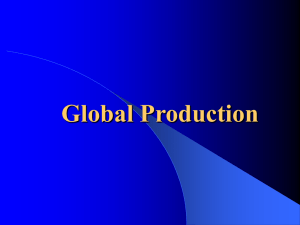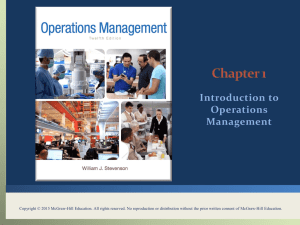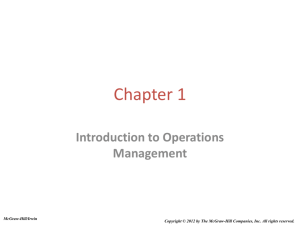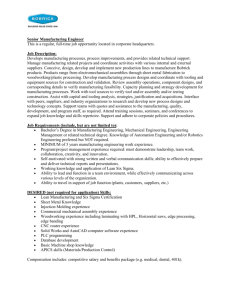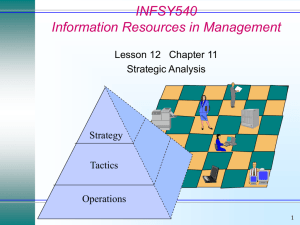Global Production, Outsourcing and Logistics
advertisement
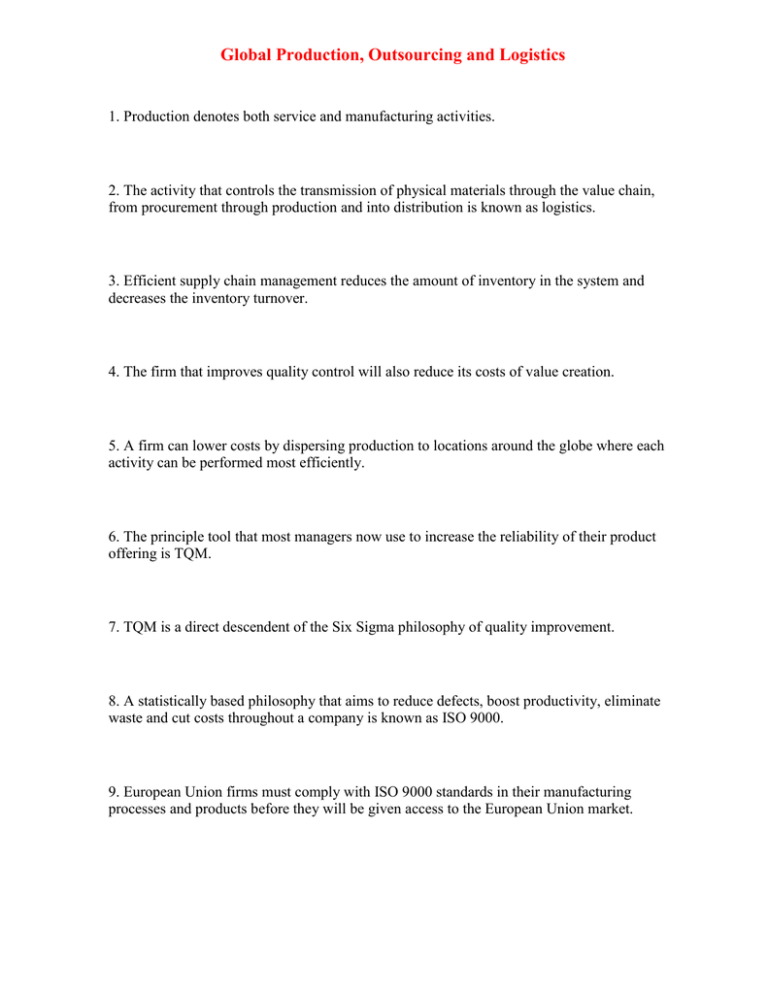
Global Production, Outsourcing and Logistics 1. Production denotes both service and manufacturing activities. 2. The activity that controls the transmission of physical materials through the value chain, from procurement through production and into distribution is known as logistics. 3. Efficient supply chain management reduces the amount of inventory in the system and decreases the inventory turnover. 4. The firm that improves quality control will also reduce its costs of value creation. 5. A firm can lower costs by dispersing production to locations around the globe where each activity can be performed most efficiently. 6. The principle tool that most managers now use to increase the reliability of their product offering is TQM. 7. TQM is a direct descendent of the Six Sigma philosophy of quality improvement. 8. A statistically based philosophy that aims to reduce defects, boost productivity, eliminate waste and cut costs throughout a company is known as ISO 9000. 9. European Union firms must comply with ISO 9000 standards in their manufacturing processes and products before they will be given access to the European Union market. 10. Country factors, technological factors and product factors, all influence the decision of where to produce. 11. When a currency depreciates, a low-cost location can be turned into a high-cost location. 12. The level of output at which most plant-level scale economies are exhausted is referred to as the minimum efficient scale of output. 13. As a plant output expands, unit costs decrease. 14. The smaller the minimum efficient scale of a plant relative to total global demand, the greater the argument for centralizing production in a single location or a limited number of locations. 15. Producing greater product variety from a factory implies longer production runs. 16. Lean production is another term for flexible manufacturing technology. 17. Economies of scale allow a firm to produce a wider variety of end products at a unit cost that at one time could only be achieved through the mass production of a standardized output. 18. Mass customization describes the ability of companies to use flexible manufacturing technology to reconcile low cost and product customization. 19. A grouping of various types of machinery, a common materials handler and a centralized cell controller is a flexible machine cell. 20. Flexible manufacturing technologies can help a firm improve efficiency, lower costs and customize products to small markets. 21. A product's value-to-weight ratio affects the firm's transportation costs. 22. Because of the low value-to weight ratio of many pharmaceutical and electronics products, there is great pressure to produce these products in the optimal location and serve the world from there. 23. Concentrating production at an optimal location is more attractive when a product serves universal needs. 24. Concentration of production makes most sense when trade barriers are high. 25. Decentralization of production is appropriate when the product serves universal needs. 26. There is a trend toward viewing foreign factories as simply being low-cost manufacturing facilities. 27. The make-or-buy decision involves deciding whether a firm should make or buy the component parts that go into the final product. 28. Historically, most outsourcing decisions have involved the manufacture of service products. 29. Outsourcing decisions pose plenty of problems for international businesses but even more problems for purely domestic businesses. 30. A firm that has integrated horizontally is making all or part of a product in-house. 31. When one firm invests in specialized assets to supply another, mutual dependency is created. 32. When substantial investments in specialized assets are required to manufacture a component, the firm will prefer to contract it out to a supplier. 33. The greatest advantage of buying component parts from independent suppliers is that the firm can maintain its strategic flexibility. 34. When political risk is high, sourcing products from independent suppliers can be advantageous. 35. Incentive problems that occur with independent suppliers do not arise with internal suppliers. 36. Strategic alliances build trust between the firm and its suppliers. 37. Strategic alliances can effectively limit a firm's strategic flexibility. 38. A CAD/CAM system allows the firm to economize on inventory holding costs by having materials arrive at a manufacturing plant just in time to enter the production process and not before. 39. Under a JIT system, products are briefly warehoused before entering the manufacturing process. 40. Firms use EDI to coordinate the flow of materials into manufacturing, through manufacturing and out to customers. Multiple Choice Questions 41. _____ is the activity that controls the transportation of physical materials through the value chain, from procurement through production and into distribution. A. Outsourcing B. Production C. Logistics D. Distribution 42. _____ is a management philosophy according to which mistakes, defects and poor-quality materials are not acceptable and should be eliminated. A. Scientific management B. Total quality management C. ISO 9000 D. Lean manufacturing 43. The Six Sigma methodology A. Is a direct descendant of the total quality management philosophy B. Is a direct descendant of benchmarking C. Was adopted first by British companies and then Japanese companies during the 1980s D. Was developed by Deming, Juran and Feigenbaum 44. Saving time by not producing poor-quality products that cannot be sold, lowering rework costs, lowering scrap costs and lowering warranty costs are the intended results of A. Total feature management B. Reengineering C. Logistics D. Total quality management 45. Before a firm is allowed access to the European marketplace, the European Union requires that the quality of the firm's manufacturing processes and products be certified under a quality standard known as A. Total quality management B. Reengineering C. Quality management system D. ISO 9000 46. The modern successor to TQM is A. Corporate Quality Commitment B. ISO 9000 C. Quality Process Realized D. Six Sigma 47. The statistically based philosophy that aims to reduce defects, boost productivity, eliminate waste and cut costs throughout a company is known as A. ISO 9000 B. TQM C. Six Sigma D. Deming's Law 48. Which of the following statements about Six Sigma is ? A. It is a statistically based philosophy B. It is easily possible for a company to achieve Six Sigma perfection C. At six sigma, a production process will have 66 defects per million units D. At six sigma, a production process would be 100 percent accurate 49. Factors that help a firm decide where to locate its manufacturing facilities can be best grouped under three broad headings. These are A. Political factors, social factors and legal factors B. Country factors, technological factors and product factors C. Product factors, service factors and labor factors D. Language factors, cultural factors and transportation factors 50. The creation of a global web of value creation activities is the result of A. Location economies B. Diseconomies of scale C. Shortage of skilled labor D. Informal trade barriers 51. Identify the incorrect statement pertaining to exchange rate movements. A. Adverse changes in exchange rates can quickly alter a country's attractiveness as a manufacturing base B. Currency appreciation can transform a low-cost location into a high-cost location C. Currency appreciation can cause firms to move their manufacturing offshore to lower-cost locations D. A low-cost location can be transformed into a high-cost location because of currency depreciation 52. Being too dependent on one location is particularly risky because of A. Floating exchange rates B. Fixed exchange rates C. Lack of movement in currencies D. Static exchange rates 53. According to the concept of economies of scale, A. As plant output reduces, unit costs decrease B. As plant output expands, unit costs increase C. As plant output reduces, unit costs remain static D. As plant output expands, unit costs decrease 54. Identify an advantage of a low minimum efficient scale. A. Allows the firm to accommodate demands for local responsiveness B. Discounts currency risk by manufacturing all products in one location C. Helps keep overheads low at the expense of fixed costs D. Helps a firm to standardize its products for all markets 55. A company that wants to reduce set-up time for complex equipment, increase the utilization of individual machines through better scheduling and improve quality control at all stages of the manufacturing process should adopt A. Standardization B. Diseconomies of scale C. Flexible machine technology D. Minimum efficient scale 56. The term _____ has been coined to describe the ability of companies to use flexible manufacturing technology to reconcile the goals of low cost and product customization. A. Assembly-line-like customization B. Economies of customization C. Mass customization D. Standardized customization 57. Flexible manufacturing technology is also known as A. Mass customization B. Lean production C. Flexible machine cells D. Minimum efficient scale 58. According to the concept of economies of scale what is the best way to achieve high efficiency and low unit costs? A. Customizing products for each individual market B. Mass producing standardized outputs C. Concentrating on production of small volumes of products D. Increasing the product variety dramatically 59. This allows the company to produce a wider variety of end products at a unit cost that at one time could be achieved only through the mass production of a standardized output. A. Kaizen B. Six Sigma C. Lean production D. TQM 60. _____ challenged the notion that the way to increase efficiency and drive down unit costs is to limit product variety and produce a standardized product in large volumes. A. Bartlett and Ghoshal's theory of a transnational company B. Minimum efficient scale C. Economies of scale D. Flexible manufacturing technology 61. A _____ is a grouping of various types of machinery, a common materials handler and a centralized cell controller. A. Flexible machine cell B. Mass customization policy C. Lean production system D. Minimum efficient scale cluster 62. All of the following are the major efficiency benefits of flexible manufacturing technologies except A. It enables companies to customize products to the demands of small consumer groups B. It helps a company achieve mass customization, which increases its customer responsiveness C. It requires firms to establish manufacturing facilities in each major market to provide products that satisfy specific consumer tastes and preferences D. It improves capacity utilization and reductions in work in progress and waste 63. When a company's product has a low value-to-weight ratio, the company should A. Should have a centralized manufacturing location B. Produce the product in multiple locations close to major markets C. Ignore transportation costs D. Produce the product in one optimal location and serve the world from there 64. Which of the following statements about products with high value-to-weight ratios is ? A. They are relatively inexpensive and weigh a lot B. They are expensive and do not weigh very much C. Transportation costs usually account for a large percentage of their total costs D. They must be produced in multiple locations close to major markets 65. Which of the following is a characteristic of manufacturing technology that should be considered by a firm contemplating international production? A. Trade barriers B. Value-to-weight ratio C. Level of fixed costs D. Exchange rates 66. A company might consider decentralizing when A. A product's value-to-weight ratio is high B. The product serves universal needs C. Trade barriers are low D. Volatility in important exchange rates is expected 67. The concentration of production makes most sense when A. Volatility in important exchange rates is expected B. The product's value-to-weight ratio is high C. Location externalities are not important D. Trade barriers are high 68. The concentration of production is favored when all of the following factors are high except A. Fixed costs B. Minimum efficient scale C. Value-to-weight ratio D. Trade barriers 69. Decisions a firm must make about whether to perform a certain value creation activity themselves or outsource it to another entity are best known as A. Outsource potential decisions B. In-house potential decisions C. Make-or-buy decisions D. Integration decisions 70. Which of the following is not an argument that supports making a product in-house? A. Vertical integration may be associated with higher costs B. Vertical integration may protect proprietary product technology C. Vertical integration may facilitate investment in highly specialized assets D. Vertical integration may ease the scheduling of adjacent processes 71. A _____ is an asset whose value is contingent upon a particular relationship persisting. A. Specialized asset B. Common asset C. Complementary asset D. Supplementary asset 72. A firm will prefer to make the component internally rather than contract it out to a supplier, because of all of the following reasons except A. It needs to maintain control over its proprietary technology B. Substantial investments in specialized assets are required to manufacture a component C. The firm completely trusts the independent supplier to play fair D. It runs the risk that suppliers will expropriate the technology for their own use 73. How can firms attain tight coordination between different stages in the production process? A. By using information technology B. By lowering the costs of value creation C. By implementing ISO 9000 D. By minimum efficient scale of output 74. Which of the following is not a reason to outsource production? A. It can give the firm greater flexibility B. It can make planning, coordination and scheduling of adjacent processes easier C. It can help drive down the firm's cost structure D. It may help the firm capture orders from international customers 75. An advantage of buying component parts or even an entire product, from independent suppliers is that A. The firm can maintain its flexibility of switching orders between suppliers as circumstances dictate B. It can make planning, coordination and scheduling of adjacent processes easier for the firm C. It reduces the risk for the firm that suppliers will expropriate the technology for their own use D. The firm is able to maintain firm control over its proprietary technology 76. Vertical integration may raise a firm's cost structure for all of the following reasons except A. The greater the number of subunits in an organization, the more problems coordinating and controlling those units B. The firm that vertically integrates into component part manufacturing may find that because its internal suppliers have an active customer, they lack the motivation to be more efficient C. Vertically integrated firms have to determine appropriate prices for goods transferred to subunits within the firm D. It makes planning, coordination and scheduling of adjacent processes more difficult, as compared to buying from independent suppliers, particularly with just-in-time inventory systems 77. The major costs saving associated with JIT comes from A. Speeding up inventory turnover B. Having materials arrive at a manufacturing plant before they are needed C. Avoiding production slowdowns by ensuring inventory is stockpiled D. Using warehouse space to maintain on-hand inventory 78. Just-in-time inventory systems A. Can help firms improve product quality B. Are fast becoming obsolete C. Require that parts be warehoused D. Give firms a buffer stock of inventory 79. Which of the following is a drawback associated with a JIT system? A. There are high transportation costs involved B. It leaves a firm without a buffer stock of inventory C. It leaves a firm with scrap costs associated with defective products D. It increases the warranty costs 80. With _____, suppliers, shippers and the purchasing firm can communicate with each other with no time delay. A. A CAD system B. A JIT system C. A CAM system D. An EDI system Essay Questions 81. What are the five interrelated issues confronting a firm as trade barriers fall and global markets develop? As trade barriers fall and global markets develop, firm face five interrelated issues. First, where in the world should production activities be located? Second, what should be the long-term strategic role of foreign production sites? Third, should the firm own foreign production activities or is it better to outsource those activities to private vendors? Fourth, how should a globally dispersed supply chain be managed and what is the role of internet-based information technology in the management of global logistics? Finally, should the firm manage global logistics itself or should it outsource the management to enterprises that specialize in this activity? 82. What is logistics? Discuss the relationship between production and logistics. Logistics is the activity that controls the transmission of physical materials through the value chain, from procurement through production and into distribution. Production and logistics are closely linked since a firm's ability to perform its production activities efficiently depends on a timely supply of high-quality material inputs, for which logistics is responsible. 83. Discuss the strategic objectives of the production and logistics functions of an international firm. The production and logistics functions of an international firm have a number of important strategic objectives. A primary objective is to lower costs. Dispersing production activities to various locations around the globe where each activity can be performed most efficiently can lower costs. Costs can also be lowered by managing the global supply chain to better match supply and demand. A second strategic objective is to increase product quality by eliminating defective products by both the supply chain and the manufacturing process. A third objective involves meeting demands for local responsiveness. Finally, production and logistics must be able to respond to shifts in customer demand. 84. What is the principle tool used by most managers to increase the reliability of their product offering? The principle tool used by most managers to increase the reliability of their product offering is the Six Sigma quality improvement methodology. Six Sigma is the successor of the total quality management philosophy that aims to reduce defects, boost productivity, eliminate waste and cut costs throughout a company. 85. What does Six Sigma refer to? Six Sigma is the modern successor to TQM. It is a statistically based philosophy that aims to reduce defects, boost productivity, eliminate waste and cut costs throughout a company. Six Sigma is the principle tool used by most managers to increase the reliability of their product offering. At Six Sigma, a production process would be 99.99966 percent accurate, creating just 3.4 defects per million units. 86. Who was W. Edward Deming? What is his contribution to business? Deming was a key contributor to the development of the total quality management (TQM) technique. Deming identified a number of steps that should be part of any TQM program. He argued that management should embrace the philosophy that mistakes, defects and poor quality materials are not acceptable and should be eliminated. He suggested that the quality of supervision should be improved by allowing more time for supervisors to work with employees, that management should create an environment in which employees will not fear reporting problems or recommending improvements and that some notion of quality should be included in work standards to promote the production of defect-free output. Deming also argued that it is management's responsibility to train workers in new skills to keep pace with changes in the workplace. According to Deming, achieving better quality requires the commitment of everyone in the company. 87. Describe the European Union's efforts to raise product quality. In your opinion, does the effort represent a trade barrier? Before a firm can gain access to the European Union marketplace, the firm must meet certain quality standards. Specifically, the European Union requires that the quality of a firm's manufacturing processes and products be certified under a quality standard known as ISO 9000. The ISO 9000 certification process has proven to be bureaucratic and costly for firms. At the same time, however, the standards have focused management attention on the need to improve the quality of products and processes. 88. What are the three main factors that affect the decision of where to locate production? The decision of where to locate production is determined by three main factors. Country factors: Include a country's economic, political and cultural conditions and their effect on the production of the firm's product. Technological factors: The type of technology a firm uses to perform specific manufacturing activities can be pivotal in location decisions. Product factors: Specifically, a product's value-to-weight ratio and whether the product serves universal needs will affect where a firm locates its production activities. 89. Discuss the effect of country factors on the decision of where to locate production? All other things being equal, a firm should locate its manufacturing activities in countries where the political, economic and cultural conditions are conducive to the performance of those activities. Other country specific factors that play a role in location decisions include formal and informal trade barriers and rules and regulations regarding foreign direct investment, expected movements in currency exchange rates and also the quality of the local labor pool. 90. What is meant by minimum efficient scale? Discuss the implications of minimum efficient scale. Minimum efficient scale of output refers to the level of output at which most plant-level scale economies are exhausted. This is the level of output a plant must operate to realize all major plant level scale economies. The concept suggests that the larger the minimum efficient scale of a plant relative to total global demand, the greater the argument for centralizing production in a single location or a limited number of locations. 91. How does the type of technology a firm uses affect its decision of where to locate production? The type of technology a firm uses to perform specific manufacturing activities can be pivotal in location decisions. The three primary factors that drive location decisions in terms of technology are a manufacturing activity's level of fixed costs, its minimum efficient scale and its flexibility. When the fixed costs of setting up a manufacturing operation are high, a firm must serve the world market from a single location or from a few locations. In contrast, when fixed costs are low, a firm can scatter its manufacturing activities throughout the world to better accommodate local markets. The larger the minimum efficient scale of a plant, the greater is the argument for centralized production at a single location. Finally, when flexible manufacturing technologies are available, a firm can manufacture products customized to various national markets at a single factory at the optimal location. 92. What is mass customization? The term mass customization has been coined to describe the ability of companies to use flexible manufacturing technology to describe the ability of companies to use flexible manufacturing technology to reconcile two goals that were once thought to be incompatible: low cost and product customization. Mass customization implies that a firm may be able to customize its product range to suit the needs of different customer groups without bearing a cost penalty. Research suggests that the adoption of flexible manufacturing technologies may increase efficiency and lower unit costs relative to what can be achieved by the mass production of a standardized output. 93. How do flexible machine cells work? What is the advantage of incorporating this type of technology into a strategy? Flexible machine cells are a common flexible manufacturing technology. A flexible machine cell is a grouping of various types of machinery, a common materials handler and a centralized cell controller (computer). Each cell normally contains four to six machines capable of performing various operations. The typical cell is dedicated to the production of a family of parts or products. The settings on machines are computer controlled. This allows each cell to switch quickly between the production of different parts or products. 94. Explain how the concept of production efficiency has changed with the rise of flexible manufacturing technologies. Flexible technology, also known as lean production, covers a range of manufacturing technologies designed to reduce setup times for complex equipment, increase the utilization of individual machines through better scheduling and improve quality control at all stages of the manufacturing process. A firm that adopts flexible manufacturing technologies can increase efficiency and lower unit costs relative to what can be achieved by the mass production of a standardized output, while at the same time allowing the firm to customize its product offering to a much greater extent than was once thought possible. In fact, flexible manufacturing technologies allow companies to produce a wider variety of products at a unit cost that at one time could only be achieved through the mass production of a standardized output. 95. How do product factors affect the decision of where to locate production? Suppose your firm produces refined sugar. Where should your firm locate production? There are two product factors that affect the decision of where to locate production. First, a product's value-to-weight ratio must be considered because of its effect on transportation costs. Students should recognize that sugar has a low value-to-weight ratio, therefore, other things being equal, there will be pressure to make these products in multiple locations close to major markets to reduce transportation costs. 96. When does concentration of production make sense? There are several situations when concentrating production facilities in a centralized location and serving the world from there makes sense. Concentration of production makes sense when the product serves universal needs, the product's value-to-weight ratio is high, trade barriers are low, important exchange rates are expected to remain stable, externalities from the concentration of like enterprises favor certain locations, differences between countries in factor costs, political economy and culture have a substantial impact on the costs of manufacturing in various countries and when the production technology has high fixed costs and high minimum efficient scale relative to global demand or flexibility manufacturing technology exists. 97. Explain how the role of foreign factories evolves over time. The strategic role of foreign factories can evolve over time. Initially, many foreign factories are established where labor costs are low and at that time, their strategic role is to produce labor intensive products at as low a cost as possible. Over time, the strategic role of the factories may evolve to one in which the factories become important centers for the design and assembly of products for the global marketplace. This change may take place as factories upgrade their capabilities as the factories respond to pressure to improve their cost structures and/or customize a product to the demands of consumers in a particular nation. In addition, as the local factors of production improve, it is easier for the factories to take on a greater strategic role. 98. Why should a firm consider vertical integration as opposed to simply outsourcing the component parts that go into its final product? What are the advantages of making a product in-house? The question of whether a firm should vertically integrate or outsource, the make versus buy decision, can be a difficult decision. A firm that chooses to make a product in-house can benefit from lower costs that may be achieved if the firm is the most efficient producer of that product in the industry, will facilitate specialized investments, will protect proprietary technology and and ease the scheduling of adjacent processes. 99. Explain why a firm might adopt the just-in-time system. Why might a firm choose a different inventory system? The JIT system was developed by Japanese firms in the 1950s and 1960s. Today, most manufacturing firms have adopted the system in some way. The basic philosophy behind just-in-time (JIT) manufacturing is to economize on inventory holding costs by having materials arrive at a manufacturing plant "just in time" to enter the product process. This results in potential cost savings and quality improvements. In addition, JIT systems can lead to quality improvements. A firm might consider a different type of inventory system in some cases because the disadvantage of a JIT system is that it leaves a firm without a buffer stock of inventory. As a result, a labor dispute at a supplier's plant or a disruption in the transportation system could leave a manufacturer without adequate component parts. 100. Discuss the role of information technology and the Internet in materials management. Web-based information systems play a crucial role in modern material management. Firms increasingly use EDI to coordinate the flow of materials into manufacturing, through manufacturing and out to customers. EDI systems require computer links between a firm, it suppliers, its shippers and sometimes its customers. These electronic links are then used to place orders with suppliers, to register parts leaving a supplier, to track them as they travel toward a manufacturing plant and to register their arrival. Suppliers typically use an EDI link to send invoices to the purchasing firm. The EDI system enables suppliers, shippers and the purchasing firm to communicate with each other with no time delay, which increases the flexibility and responsiveness of the whole supply system. The EDI system also eliminates much of the paperwork between suppliers, shippers and the purchasing firm.

